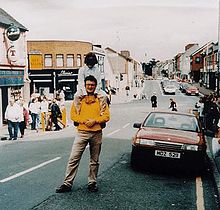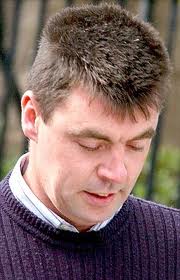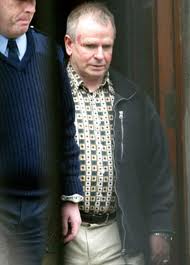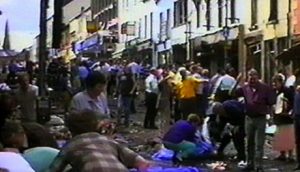TWO men sued over the Omagh bomb have been found liable for the 1998 atrocity at their civil retrial in Belfast.
Colm Murphy and Seamus Daly were taken to court by the victims’ families who were seeking damages for the atrocity.
On Wednesday, civil trial Judge Mr Justice Gillen said he found both Daly and Murphy liable for “trespass against the person” over the Real IRA bombing.
And he described Murphy’s explanations about the use of his mobile in the attack as “lies”.
Twenty-nine people, including a woman pregnant with two unborn twins, were killed in the Real IRA attack on the County Tyrone town on Saturday, August 15, 1998.
No-one has been successfully convicted in a criminal court of the bombing.
In the absence of criminal convictions, the victims’ families took a landmark civil action, seeking damages from the men they believed were responsible.
The retrial followed the original Omagh bomb civil case, which is believed to be the first time anywhere in the world that alleged members of a terrorist organisation have been sued.
The first trial concluded in June 2009, when a judge ruled that four men – Real IRA leader Michael McKevitt, Liam Campbell, Colm Murphy and Seamus Daly – were all responsible for carrying out the atrocity.
The 12 relatives who had taken the action were awarded more than £1.6m in damages.
However, the four men who were found liable subsequently launched appeals.
Michael McKevitt and Liam Campbell failed for have the civil judgement against them overturned two years later.
Colm Murphy and Seamus Daly were successful in upholding their appeals in July 2011, but the pair were then ordered to face a retrial of the civil case.
Mr Murphy a Dundalk-based publican and contractor, and former employee Seamus Daly, from Cullaville, County Monaghan, denied playing central roles in the atrocity.
It was the Omagh families’ case that Mr Murphy provided two mobile phones to the Real IRA bombers and that Mr Daly used one of the phones during the bomb run between Dundalk and Omagh.
In his 78-page judgement, trial judge Mr Justice Gillens said he was satisfied that the Omagh families had proved the case of “trespass to the person” against Colm Murphy to the requisite standard.
He said there was compelling circumstantial evidence that two phones (with phone numbers ending in 585 and 980) were used in the Omagh bombing.
A study of the use of these phones revealed a picture inferring movement in vehicles in the same direction from the Republic of Ireland to Omagh and then back to the Republic.
The judge said the movement and timing of the calls emanating from these phones led him to the irresistible inference that the sequence of events was wholly consistent with a bomb car and probably a scout car participating in the bombing.
The judge also said there was a reasonable inference that the bombing was carried out by people who set a pattern of telephone calls both prior to and subsequent to the bombings including telephone warnings wholly consistent with the pattern of calls made by the 585 and 980 phones.
Mr Justice Gillen said he was satisfied that those who provided or used these mobile phones played a central role in the tort of trespass to the person and were joint tort-feasors.
He was also satisfied that the strength and quality of the telephone evidence was sufficient to justify the inference he had drawn and reiterated that he had determined that anyone such as Murphy who knowingly lent his phone to those involved in the bombing played a vital role in this joint enterprise, assisted in the bombing and was a joint tort-feasor.
Mr Justice Gillen said the pattern of movement of the phones had demanded an explanation from Murphy who was clearly in a position to provide information as to how it came about that his mobile phone was located to and from Omagh on the day of the bombing, and in whose possession it was or to provide a rational explanation as to how that phone came to be there.
In interviews with the Garda on 21 and 22 February 1999, Murphy denied lending his 585 phone to anyone on the day of the bombing, making any calls from 585 to the 980 phone on that day, ever being in Omagh and had no rational explanation for how the 585 phone came to be used without his knowledge. The judge said that Murphy’s explanations were “wholly implausible and in my view amount to lies”.
Mr Justice Gillen disagreed with Counsel’s contention that there was no evidence that Murphy knew the purpose for which his phone was to be used.
He said that Murphy’s “failure to provide any rational explanation whatsoever as to the presence of that phone on the day of the bombing and the untruths which he told to the police about this matter in the context of the enormity of the crime about which he was being questioned all serve to convince me that there was a strong prima facie case that he was fully aware of the use to which that phone which he had provided was to be put”.
The judge also determined that the coincidence of a similar unexplained use by the same phone 585 in the Banbridge bombing was further probative evidence of Murphy’s involvement in the Omagh bombing:
“To suggest that for a second time his phone had been mysteriously used without his knowledge moves one into the realm of fantasy”.
Mr Justice Gillen also drew an adverse inference against Murphy in light of his failure to give evidence or call any witnesses to explain the presence of the 585 phone in Omagh, or for that matter in Banbridge on the day of that bombing. He said this strengthened the overall evidence against Murphy and satisfied him, taking all the factors cumulatively, that he should make a finding in favour of the plaintiffs against Colm Murphy on the grounds of trespass to the person.
Mr Justice Gillen was he was also satisfied that the plaintiffs had proved the case of “trespass to the person” against Seamus Daly.
He referred to evidence given by Denis O’Connor who had met a man describing himself as Seamus Healey on a number of occasions about the use of a C2 Contractor’s Certificate to evade tax.
O’Connor was interviewed by Garda officers on 22 February 1999 and identified Seamus Daly from a photograph as the man he knew as Seamus Healey.
The phone records indicated that a call was made from the 585 phone to O’Connor at 3.30 pm on the day of the Omagh bombing. Mr Justice Gillen said he was satisfied on the balance of probabilities that it was Daly who called O’Connor that day.
The judge added that Daly had readily admitted having dealings with Murphy through work for a number of years and that highlighted the coincidence of him being in possession of Murphy’s 585 phone.

Omagh town centre seconds before bomb went off. Spanish father and son picture miraculously survived the attack
Mr Justice Gillen said that whilst the conversation with O’Connor would have been sufficient to have established a case against Daly, he also took into account his plea of guilty in 2004 to an offence of membership of a terrorist organisation in 2000 and said he was satisfied that this amounted to a public confession of his involvement with IRA terrorist activity.
The judge said that Daly had given no explanation at any time to the Garda or anyone else for his possession of the 585 phone on the day of the bombing even though the circumstances of its possession “cry out for an explanation”.
He also determined that the coincidence of a similar unexplained use of Daly’s phone (ending in the numbers 213) in the Lisburn bombing was further probative evidence of his involvement in the Omagh bombing.
Mr Justice Gillen also drew an adverse inference from Daly’s failure to give evidence or call witnesses.
He said he could find no credible explanation why Daly failed to go into the witness box as he could have provided an explanation why he was in possession of the 585 phone on the day of the Omagh bombing or why his 213 phone was present in Lisburn on the date of the Lisburn bombing.
Alternatively he could have called evidence which would have strengthened the alibi for his movements on 15 August 1998 that he gave to the police.
Mr Justice Gillen concluded on the basis of the evidence that he was satisfied that Daly was liable in this action to the plaintiffs on the grounds of trespass to the person.






